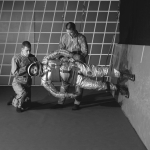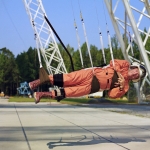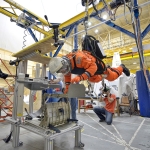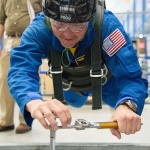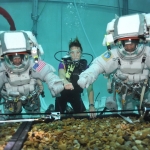Since the early 1960s NASA has employed reduced gravity walking simulators and gravity-offload rigs (e.g. ARGOS) to provide astronauts with training for movement in reduced gravity and micro-gravity environments. While we cannot reduce the actual gravitational pull of the mass beneath our feet, we can simulate to varying degrees of accuracy, the effect of a reduced or fully diminished field of gravity and how it affects our ability to maneuver across varied terrain.
Reduced gravity simulators were used in training the Apollo astronauts to learn how to walk on the Moon before arriving. They discovered that a “bunny hop” or skip was the most effective means of travel by foot as normal walking was impaired by the cumbersome nature of the massive pressure suits. Hollywood too uses gravity-offset rigs to simulate space walks, movement in micro-gravity, free-fall, and martial arts fights in which a powerful punch sends someone spinning through space.
The Reduced Gravity Simulator (RGS) at SAM enables visitors to experience reduced weight with or without donning a pressure suit, moving in full 1g, 1/3g for Mars, 1/6g for the Moon, and anything in between. In addition, we host experiential education programs for school-age students who desire to learn more about human space exploration. The result is a breathtaking, memorable experience for learners of all ages.


